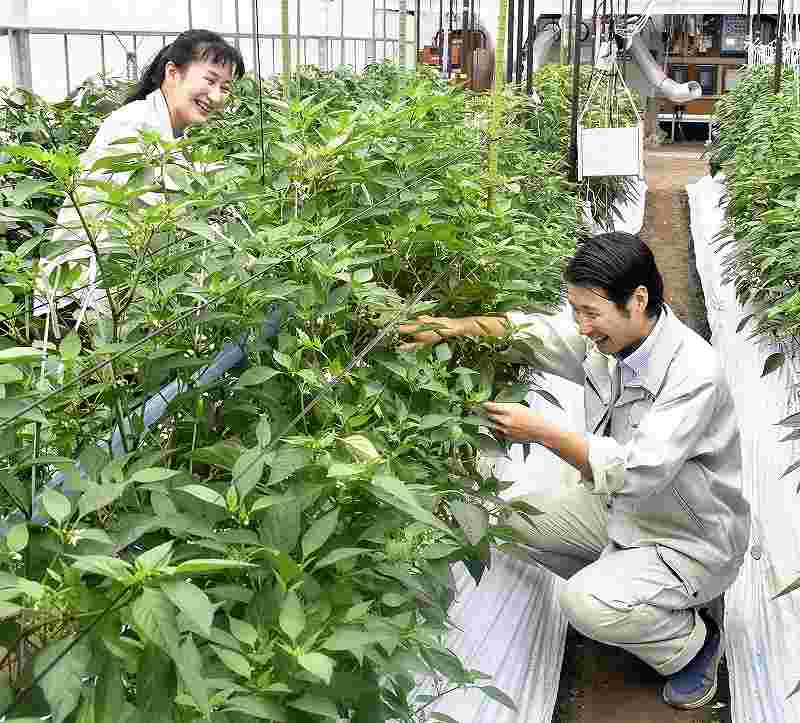
Satowa Nabeshima, left, and Ko Ozaki check the growth of shishito peppers at the Kochi Agricultural Research Center in Nankoku, Kochi Prefecture.
14:00 JST, November 8, 2022
KOCHI — Shishito, a mild Japanese green pepper, can be found in various kinds of dishes served at eateries such as izakaya. But some people avoid using them in school lunches and home cooking because every now and then it’s possible to stumble across a fiery hot one.
In a bid to improve the image of the unpredictable pepper, the Kochi Agricultural Research Center developed a non-spicy shishito variety after 10 years of research. Kochi Prefecture boasts Japan’s largest shipment of shishito peppers. The center plans to start selling seeds of the variety to farmers in the prefecture at the beginning of next year, and hopes the non-spicy peppers will be available to buy in grocery stores across the nation.
Kochi Prefecture shipped 2,210 tons of shishito in 2020. The prefecture accounts for more than 40% of the Japanese market, and that market share exceeds 80% for peppers cultivated in greenhouses during the off-season period from winter to spring.
The center touted the vitamin-rich pepper to local elementary schools for use in lunches, but many schools declined the offer because sometimes the peppers pack a punch.
Some elementary school students who visited the center on field trips said they did not even know what shishito was.
Satowa Nabeshima of the prefecture’s environmental agriculture promotion division, had been striving to develop non-spicy shishito peppers since 2012.
Nabeshima said the research started because she wanted to get “more people to appreciate the appeal of Kochi’s shishito.” Shishito that are very spicy tend to be hard and have a dull, dark-green luster, among other characteristics. Farmers normally remove such peppers during harvesting and shipping, but it is difficult to catch them all.
Researchers at the center checked the appearance and aroma of the peppers, and the growth of seeds. And of course, they also tasted the fruits of their labor. The center spent about ¥4 million on fertilizers, pesticides and other research expenses from fiscal 2016 to 2020.
In 2020, researcher Ko Ozaki took over from Nabeshima. “I tasted more than 1,000 shishito a day sometimes, and took a few hits when I came across spicy ones,” said Ozaki, 30. “That made me want to produce non-spicy peppers even more.”
Through repeated crossbreeding, the center selected seedlings that lacked the gene responsible for the fiery hit, and in March this year, the researchers finally developed a variety that tastes like conventional shishito, is easy to grow and definitely won’t pack a punch.
After filing an application with the Agriculture, Forestry, and Fisheries Ministry to register the shishito, the center plans to market it as a regional specialty in the autumn of next year.
“I hope children will eat a lot of shishito, and that household consumption will increase significantly,” Nabeshima said.
"Features" POPULAR ARTICLE
-

Sanrio to Open Museum in Yamanashi Pref. Dedicated to Founder, Exhibits Include Hello Kitty, Other Characters
-

Autumn Foliage Surrounds Visitors to Tokyo’s Showa Kinen Park
-

My Daughter No Longer Speaks to Me, But I Want to See Her and My Grandchild
-

Kumamoto: Public Bath Refurbished as Library Where You Can Chat, Take Photos
-

Frozen Vegetables: Demand Rises for Convenient, Tasty Domestic Produce
JN ACCESS RANKING
-

Keidanren Chairman Yoshinobu Tsutsui Visits Kashiwazaki-Kariwa Nuclear Power Plant; Inspects New Emergency Safety System
-

Imports of Rare Earths from China Facing Delays, May Be Caused by Deterioration of Japan-China Relations
-

University of Tokyo Professor Discusses Japanese Economic Security in Interview Ahead of Forum
-

Japan Pulls out of Vietnam Nuclear Project, Complicating Hanoi’s Power Plans
-

Govt Aims to Expand NISA Program Lineup, Abolish Age Restriction























